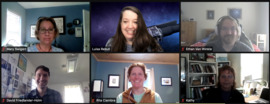Search iN AfGl 490 (SNAG490) will be looking for young stellar objects (YSOs) in AFGL490.
Based on theoretical models and observations, it is thought that most stars form in clusters, although much about cluster formation and evolution is still unknown. Sometimes, young stellar objects (YSOs) are so embedded in envelopes of gas and dust that a complete list of YSOs in a cluster is difficult to obtain. Having a complete list of cluster members is useful in order to compare the cluster’s properties to other, older clusters. Our project will be to work toward the development of a complete membership list for the cluster of YSOs emerging from the dust cloud surrounding the high mass star AFGL 490. This embedded cluster of low-mass stars around the high-mass (8-10 M☉) star AFGL 490 (see Straižys & Laugalys 2008 and references therein), is located within the plane of the Galaxy in the Cam OB1 association. This research will build upon work done by Gutermuth et al. (2009) and Masiunas et al. (2012), who studied this cluster with Spitzer/IRAC (Infrared Array Camera) and MIPS (Multi-band Imaging Photometer for Spitzer), identifying several hundred YSO candidates from their infrared (IR) excesses, which are associated with dust surrounding each of the YSOs. The YSOVAR (YSO VARiability) project (Rebull et al. 2014) also monitored this region with Spitzer/IRAC, but no one has yet explored the light curves (graphs of light variability vs. time) in detail. Since those works were published, several optical databases have become available in this region (Panoramic Survey Telescope and Rapid Response System [PanSTARRS], INT Photometric H-Alpha Survey [IPHAS], and Gaia). We propose to collect all of the literature-identified YSOs, combine several archival optical (PanSTARRS, IPHAS, and Gaia) and IR (Spitzer/IRAC & MIPS, Wide-Field Infrared Survey Explorer [WISE], Herschel/Photodetector Array Camera and Spectrometer [PACS], Akari, Midcourse Space Experiment [MSX]) data sets, and identify new candidate YSOs using IR excesses, g-band excesses, and hydrogen-alpha (H𝛂) excesses. We will then use the merged data to assess all of the candidate YSOs using image inspection, spectral energy distributions, and color-color/color-magnitude diagrams to identify which targets are most likely to be YSOs. If time permits, we will also explore the variability characteristics of these YSOs in the IR using the YSOVAR data.
Caltech, Pasadena, California
The Bay School of San Francisco, San Francisco, California
Peoples Academy, Morristown, Vermont
GLAS Education, Walworth, Wisconsin
Southeast High School, Lincoln, Nebraska
Many NITARP alumni helped us out with reviewing the NITARP 2022 proposals. Scientists who helped include Chris Gelino, Mike Kuhn, and Julian van Eyken. Thanks to all!
